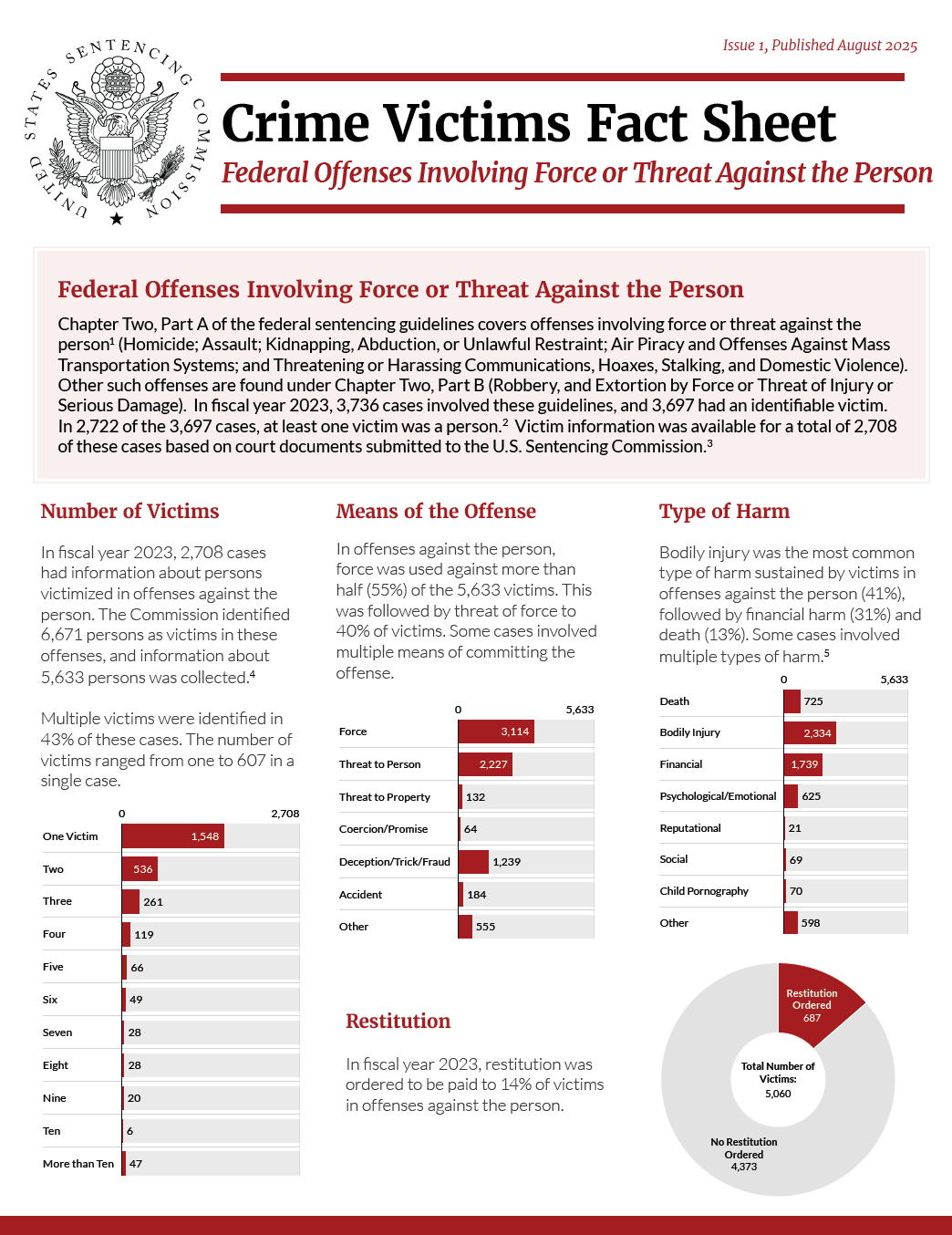CRIME VICTIMS FACT SHEET
Federal Offenses Involving Force or Threat Against the Person
Chapter Two, Part A of the federal sentencing guidelines covers offenses involving force or threat against the person1 (Homicide; Assault; Kidnapping, Abduction, or Unlawful Restraint; Air Piracy and Offenses Against Mass Transportation Systems; and Threatening or Harassing Communications, Hoaxes, Stalking, and Domestic Violence). Other such crimes are found under Chapter Two, Part B (Robbery, and Extortion by Force or Threat of Injury or Serious Damage).
In fiscal year 2023, 3,736 cases involved these guidelines and 3,697 had an identifiable victim. In 2,722 of the 3,697 cases, at least one victim was a person.2 Victim information was available for a total of 2,708 of these cases based on court documents submitted to the U.S. Sentencing Commission.3
Click the button for a PDF or learn more below.
NUMBER OF VICTIMS
In fiscal year 2023, 2,708 cases had information about persons victimized in offenses against the person. The Commission identified 6,671 persons as victims in these offenses, and information about 5,633 persons was collected.4
Multiple victims were identified in 43% of these cases. The number of victims ranged from one to 607 in a single case.
MEANS OF THE OFFENSE
In offenses against the person, force was used against more than half (55%) of the 5,633 victims. This was followed by threat of force to 40% of victims. Some cases involved multiple means of committing the offense.
TYPE OF HARM
Bodily injury was the most common type of harm sustained by victims in offenses against the person (41%), followed by financial harm (31%) and death (13%). Some cases involved multiple types of harm.5
RESTITUTION
In fiscal year 2023, restitution was ordered to be paid to 14% of victims in offenses against the person.
RELATIONSHIP BETWEEN VICTIMS AND INDIVIDUALS WHO CAUSED HARM
In offenses against the person, the most common association between victims and the individuals who caused them harm was as a stranger (52%). The next most common was as an acquaintance (17%). Some cases involved multiple relationship types.
55% of victims in offenses against the person were harmed by more than one individual.
VULNERABILITY
Some offenses against the person involved victims who were unusually vulnerable due to age, physical or mental condition, or other factors.6 The Commission identified 6% of victims in these cases as unusually vulnerable for one of these reasons. Some cases involved multiple vulnerabilities.
VICTIM CHARACTERISTICS
One-tenth (10%) of victims in offenses against the person were juveniles.
More than one-third (35%) of victims in offenses against the person were female.
ENDNOTES
1 Federal Offenses Involving Force or Threat Against the Person include individuals sentenced in fiscal year 2023 in cases involving USSG §§2A1.1 (First Degree Murder); 2A1.2 (Second Degree Murder); 2A1.3 (Voluntary Manslaughter); 2A1.4 (Involuntary Manslaughter); 2A1.5 (Conspiracy or Solicitation to Commit Murder); 2A2.1 (Assault with Intent to Commit Murder; Attempted Murder); 2A2.2 (Aggravated Assault); 2A2.3 (Assault); 2A2.4 (Obstructing or Impeding Officers); 2A4.1 (Kidnapping, Abduction, Unlawful Restraint); 2A5.2 (Interference with Flight Crew Member or Flight Attendant; Interference with Dispatch, Navigation, Operation, or Maintenance of Mass Transportation Vehicle); 2A5.3 (Committing Certain Crimes Aboard Aircraft); 2A6.1 (Threatening or Harassing Communications; Hoaxes; False Liens); 2A6.2 (Stalking or Domestic Violence); 2B3.1 (Robbery); or 2B3.2 (Extortion by Force or Threat of Injury or Serious Damage). This excludes Chapter Two, Part A, Section Three (Criminal Sexual Abuse and Offenses Related to Registration as a Sex Offender) cases, which have been included in the Federal Sex Offenses Crime Victims Fact Sheet. Multiple sentencing guidelines may have been applied in these cases, including some not listed above.
2 An identifiable victim can be a person, business, government, or other type. This series provides victim information on persons.
3 The Commission’s Crime Victims Fact Sheets series relies on information collected and analyzed through a special coding project undertaken by the Commission to gather information beyond what is regularly collected and reported on by the Commission.
4 The sentencing documents received from the courts by the Commission are often focused on the sentencing event; therefore, some information regarding the victims of the offense was not provided in the documents available for staff review. For this reason, the total number of cases with complete information, and the corresponding number of victims in those cases, will vary by analysis. Victim information was collected for the first ten persons documented in the records.
5 In a small number of cases, the type of harm resulted from additional counts of conviction for offenses other than the ones discussed in this fact sheet. All of the harm types involved in a case are reported in this fact sheet.
6 In some, but not all, of these cases the court applied the adjustment at USSG §3A1.1. Vulnerability due to advanced age or youthfulness was determined by the offense conduct stated in the presentence investigation report adopted by the court, and not based on any minimum or maximum age.
SOURCE: U.S Sentencing Commission, 2023 Victim Datafile, VICFY23.

